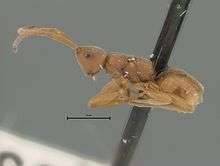Embolemidae
Embolemidae is a small family of around 20 species and 2 genera distributed around the world.[1] They are small, sometimes very small, solitary wasps. The biology of the Embolemidae is little known, although a Nearctic species, Embolemus confusuus, was reared from the nymph of a planthopper from the family Achilidae where its host fed on fungi beneath the bark of rotting logs. The parasitoid lived in a bulging sac attached to the host nymph between the second and third segments.[2][3] The females are wingless while the males have wings and in temperate regions emerge later than the females, which overwinter as adults.[4] The wingless females have been recorded from the nests of ants and small mammal burrows,[1] or under stones in pastures and grasslands and they appear to act as ant mimics. The Palearctic species, Embolemus ruddii has been found in association with the ant species Formica fusca and Lasius flavus, while in Japan Embolemus walkeri was taken in a nest of another ant from the genus Myrmica.[2]
| Embolemidae | |
|---|---|
 | |
| Embolemus nearcticus | |
| Scientific classification | |
| Kingdom: | Animalia |
| Phylum: | Arthropoda |
| Class: | Insecta |
| Order: | Hymenoptera |
| Superfamily: | Chrysidoidea |
| Family: | Embolemidae Förster, 1856 |
| Genera | |
References
- Simon van Noort (2017). "Embolemidae". WaspWeb: Hymenoptera of the Afrotropical region. Iziko Museums of South Africa. Retrieved 8 July 2017.
- C. van Achterberg; R.J.M. van Kats (2000). "Revision of the Palaearctic Embolemidae (Hymenoptera)". Zoologische Mededelingen. 74: 251–269.
- "HYMENOPTERA, Embolemidae (Chrysidoidea) (formerly Bethyloidea)". University of California, Riverside. Retrieved 8 July 2017.
- J.T. Burn (1997). "Embolemus ruddii (Westwood,1833)". Bees, Wasps and Ants Recording Society. Retrieved 8 July 2017.